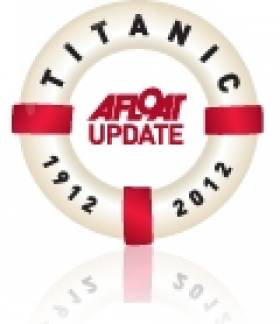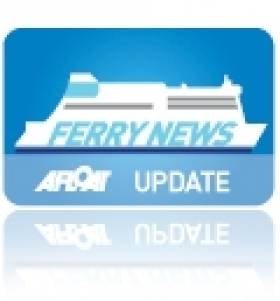Displaying items by tag: Belfast
Walking Tours a Highlight of Belfast's TItanic Festival
#TITANIC - Belfast's Titanic Festival is set for 31 March to 22 April, with lectures, concerts, plays, city tours and exhibitions among the events lined up to recognise the centenary.
The centrepiece will be a wreath laying ceremony at the Titanic Monument at Belfast City Hall, in remembrance of the 112 Ulster natives who died when the ill-fated ship went down on 12 April 1912.
Visitors to the city during the festival can take part in various walking tours, both solo - using a portable 'Node Explorer' available from the Belfast Tourist Bureau - and escorted, with most having the memorial as their starting point.
The National's Kevin Pilley follows one tour guide, former soldier Pat, on his two-hour Titanic-themed tour around the city.
Pat has a specific connection to the TItanic, as his grandfather Danny died in the tragedy - but little does he know Pilley's own connection to that fateful day.
The National has more on the story HERE.
Plaque Honours Famous Playwright and Titanic Orphan
#TITANIC - A plaque honouring Titanic orphan and playwright William Ruddick Millar has been unveiled in his hometown of Carrickfergus, the News Letter reports.
Millar was orphaned at five years old when his father, a deck engineer on the ill-fated ocean liner, went down with the ship after it struck an iceberg on 15 April 1912.
He faced a difficult childhood, he and his brother Thomas joining their eight cousins under the care of a great aunt.
But by the age of 18 he had already seen one of his plays performed at the Grand Opera House in Belfast.
In the decades after he became a renowned author famous for titles such as Stirabout, When Johnny Comes Marching Home and The Land Girl. He also wrote for radio as well as books and newspaper articles.
Great-granddaughter Susie Millar was on hand for the unveiling at the cottage where he was raised by his great aunt. “Our entire family are so proud to have him remembered in this way," she said.
The News Letter has much more on the story HERE.
Requiem for Titanic Victims on 100th Anniversary
#TITANIC - Philip Hammond's Requiem for the Lost Souls of the Titanic will be staged at St Anne's Cathedral on the centenary of the tragedy, BBC News reports.
The Belfast composer has spent over three years working on the "haunting" music that will pay tribute to the more than 1,500 people who lost their lives when the TItanic sank in 1912.
His requiem uses phrases from variations of the 'Nearer My God to Thee' and takes influence from Irish folk songs from the 1792 Belfast Harp Festival.
Accompanying the music will be lyrics from the original Latin Requiem Mass sung by the Belfast Philharmonic Society, Anuna, the Schola Cantorum of St Peter's Cathedral, Belfast, and Cappella Caeciliana.
The cathedral itself will also be part of the story, with seating arranged to imitate that on a ill-fated ship.
"It is part of history and it is part of who we are," said Hammond of the Titanic story.
BBC News has more on the story HERE.
Titanic Belfast Bosses Want the ‘T Factor’ in Frontline Job Audtions
#TITANIC - Prospective employees at the soon-to-be-opened Titanic visitor centre in Belfast will have to show the ‘T factor’ and give a performance on aspect of the doomed ship’s story, The Irish Times reports.
It’s hoped by bosses at Titanic Belfast that the three-minute scripted ‘interpretative presentation’ - based on one of the centre’s nine galleries - will indicate those candidates with the requisite passion and communications skills for one of the 70 “frontline” jobs up for grabs.
“The audition day will give prospective employees a chance to let their true personalities shine through,” said Titanic Belfast chief executive Tim Husbands.
Titanic Belfast will be one of the largest employers in Northern Ireland’s tourism industry when it opens in March, as well as one of the North’s largest recruiters.
Among its many attractions, it will also bost the region’s largest function suite for conference, weddings and other events, as previously reported on Afloat.ie.
The Irish Times has more on the story HERE.
Ship-to-Ship Transfer of OIl Cargo Delayed Yet Again
#SHIPPING - The transfer of hazardous cargo from the stricken tanker at the entrance to Belfast Lough has been delayed yet again due to winds nearing hurricane strength.
The Belfast Telegraph reports that the Genmar Conpanion - which was redirected to Belfast after reporting a cracked hull en route from Rotterdam to New York - will remain sheltering off the Copeland Islands until the weather improves.
As previously reported on Afloat.ie, the ship-to-ship transfer of 54,000 tonnes of vacuum gas oil was originally scheduled to take place on 31 December last, but the task was pushed back as the receiving ship, BW Seine, was delayed by weather in the North Sea.
It had then been hoped to begin the transfer early yesterday with the receiving ship's arrival, but the strong storm-force winds that have increasingly battered Ireland in the last 36 hours put paid to those plans.
Ship-to-ship transfers can take place in wind speeds of up to 35 knots, but yesterday the wind speed in Belfast Lough was reported as more than double that.
Hugh Shaw, the NI Secretary of State's representative for maritime salvage and intervention, told the Belfast Telegraph: "As soon as we have a window to do the ship-to-ship transfer safely we will take it.
"Winds have been dropping a bit, but it looks unlikely the operation will take place on Wednesday."
Transfer of Cargo from Stricken Tanker Delayed
#SHIPPING - The transfer of cargo from the damaged oil tanker sheltering at the entrance to Belfast Lough has been posponed for at least two more days.
As previously reported on Afloat.ie, the 228-metre Germar Companion - which is carrying 54,000 tonnes of vacuum gas oil - was redirected to Belfast after reporting a cracked hull en route from Rotterdam to New York.
The merchant vessel has been sheltering off the Copeland Islands since 16 December, where an official examination recommended removal of the cargo.
Today (31 December 2011) had been the scheduled start date for the move of the tanker's hazardous cargo by ship-to-ship tranfer. But the move has been delayed as the second ship, the BW Seine, is still en route to Belfast Lough.
"It is currently in the North Sea and could take another two days before it reaches the vessel and starts to transfer the cargo," a coastguard spokesperson told the Belfast Telegraph.
The transfer will be managed by specialist company Fendercare Marine in the lough, and could take between 24 and 36 hours. Once finished, the Germar Companion will sail into Belfast for repairs.
Belfast to Welcome Tall Ships in 2015
#TALL SHIPS - Ireland will be getting a triple dose of the Tall Ships Races this decade - after Waterford last year and Dublin next summer - as Belfast has been chosen to host the first leg of the event in 2015, BBC News reports.
Belfast City Council made the official announcement this afternoon, with Belfast Lord Mayor Niall O Donnghaile saying the return of the event in July 2015 was "another very real endorsement of Belfast's ability".
Northern Ireland's capital last hosted the tall ships in 2009, when some 800,000 visitors thronged the city to see 40 vessels in a parade of sail.
BBC News has more on the story HERE.
New Belfast-Cairnryan Route Celebrates First Sailings
#FERRY NEWS - Demotix reports that the first ferries have sailed to Northern Ireland from the new £200m Stena Line port facility at Cairnryan in western Scotland.
The company's final sailings from Stranraer took place at the weekend before the official relocation to the new port, which lies closer to the mouth of Loch Ryan and the North Channel.
As previously reported on Afloat.ie, the Stena Superfast VII is serving the new route following the mothballing of the Stena Voyager service.
The ferry and her sister ship Stena Superfast VIII are on charter from Scandinavian ferry operator Tallink, and are the largest ferries ever to service the North Channel route.
Images of the new Belfast-Cairnryan Stena Line crossing are available HERE.
New Owners for 'Iconic' Hotel on Strangford Lough
#WATERFRONT PROPERTY - A 14-bedroom hotel overlooking Strangford Lough has been purchased by the owners of the five-star Merchant Hotel in Belfast.
Caterer and Hotelkeeper reports that the Portaferry Hotel will undergo a £100,000 (€116,700) refurbishment under its new ownership by the Beannchor Group, which is expected to help create 10 new jobs.
Bill Wolsey of the Beannchor Group said he was excited about the prospects for the "iconic" 18-century landmark.
"The restaurant has one of the finest food offerings in the area and I am confident it will be quickly established as a firm favourite with food lovers in the Ards Peninsula and further afield," he said.
Waterfront Development Opportunities in Northern Ireland, Waterford
#WATERFRONT PROPERTY - A number of prime waterside development opportunities are up for grabs in Northern Ireland and Waterford.
North of the border, Northern Ireland Electricity (NIE) is currently seeking expressions of interest for three sites.
The first of these, in Belfast, is the site of the former Belfast West Power Station. The 16-acre site on McCaughey Road, close to the city centre, is currently zoned as employment/industry.
Further north on the shores of Belfast Lough is a 45-acre whiteland site adjacent to Kilroot Power Station in Carrickfergus. Both Kilroot and Belfast West will be available for lease only due to their strategic nature.
Also available are lands adjacent to Coolkeeragh Power Station, near Derry and the mouth of the Foyle. This 28-acre site is zoned as existing industry.
All three sites are restricted to generation or other electricity industry uses.
The closing date for expressions of interest is 12 noon on 20 February 2012. For more contact Savills Belfast at +44 (0) 28 9026 7820 or [email protected].
Meanwhile, in Waterford, estage agent Purcell Properties is guiding €1.5 million for an 18-acre landbank with extensive frontage on the Suir, less than a mile from the city centre.
The site at Newrath, previously used by Smurfit for plastic production, comprises mixed warehousing developed around 50 years ago.
The landbank is close to the new bridge connecting with the Waterford-Dublin motorway. Zoning of the site would allow mixed use including retail, light industrial and warehousing.
For more details contact Purcell Properties at 051 876 514 or [email protected].







































































